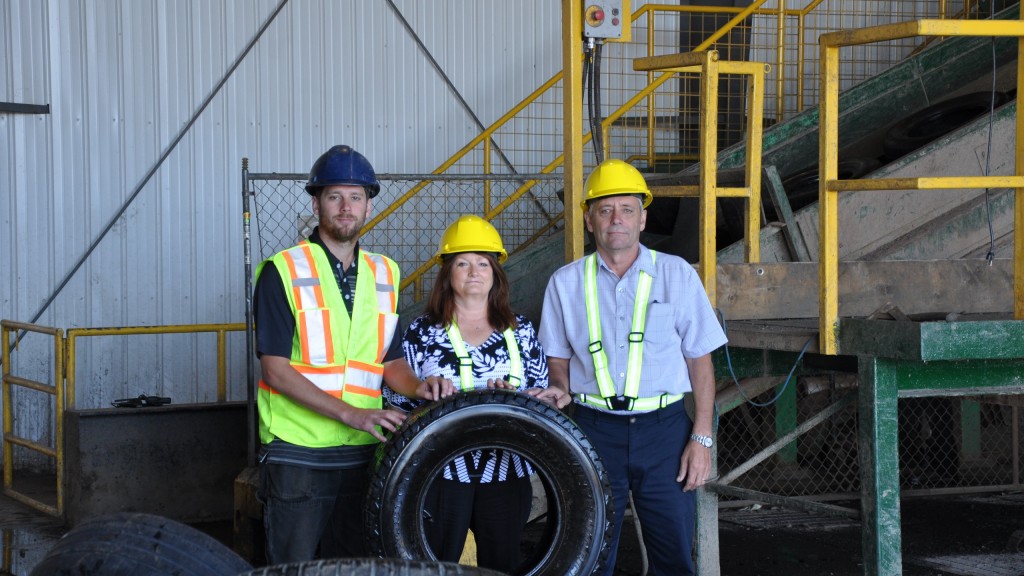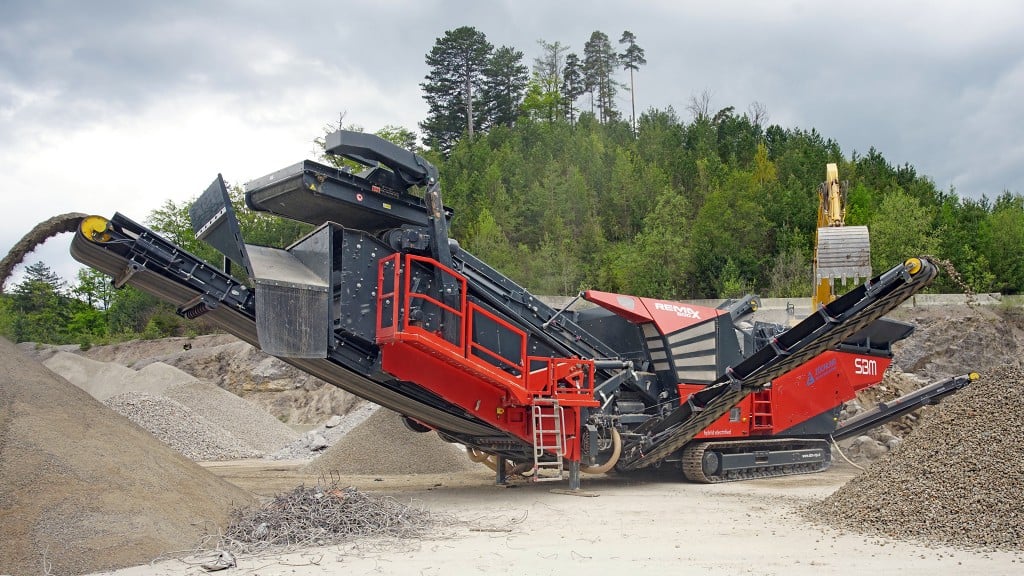Fighting for tires in Nova Scotia
For Halifax C&D Recycling – a business built on processing difficult materials – a decision to divert used tires away from the recovery stream is cause for concern

There aren't many recycling companies that can say they were the first in their province to lead the way in advancing various programs for reclamation of what would otherwise be waste. For Halifax C&D Recycling, it's a badge of honour they wear with pride.
With more than two decades in operation, the family-owned company - named after the city where it was founded in 1995 - is a leader in construction and demolition recycling. They have consistently been the first in Nova Scotia to take on difficult jobs, which has led to significant growth as well as accolades from the provincial government. About eight years ago, the company turned some of its focus to recycling tires - the first in the province to do so. Earlier this year however, they found themselves facing a decision from Divert NS, the provincial non-profit corporation that manages the Used Tire Management Program. The decision was made to divert about 30 percent of the approximately one million used tires available for recycling in the province yearly, towards a waste-to-energy pilot project that will be burning the tires for energy. Many in Nova Scotia are very concerned about this development. For the Chassies, it not only adds to the challenges of sustaining a successful recycling business, but has the family wondering about the future of recycling in their region.
A pioneer in C&D
When Dan and Lee-Anne Chassie founded Halifax C&D Recycling, there was no construction and demolition recycling industry in the province. According to Mike Chassie, vice president, in the mid-nineties the timing was perfect for the establishment of a C&D operation.
"This was right along the time when the province decided to change the way it handled waste; it was planning to become a leader in Canada and North America," Mike Chassie explained. "Before that, everything was just being landfilled in either C&D-specific landfills or in solid waste fills. The business plan for Dan and Lee-Anne at the time was to focus on two things: wood waste and post-consumer shingles."
The intention was to recycle shingles into recycled asphalt paving, and to take advantage of the launch of various biomass processing plants that were getting their start at the same time.
Volume a challenge
In a small province like Nova Scotia, construction and demolition waste is a challenging sector to break into for one reason: volume.
"Halifax generates high-five figures to low-six figures of construction and demolition debris waste tonnage each year, but if you go outside of the population centres, there's just not a lot of waste created to encourage recycling," Chassie said. "It also comes down to private operators having to compete with municipal operations, or recyclers competing with private operators who just want a landfill. It's always going to be cheaper to landfill material than it is to recycle."
Halifax C&D Recycling originally stepped into this difficult landscape as a one-man operation. Today, it employs 60 people full-time and works with numerous contractors. However, even with that growth, the process for handling material has stayed relatively similar over time.
While there are machine sorting options available, Halifax C&D Recycling has stuck with hand sorting because its volume, while impressive, doesn't quite reach the level where mechanical assistance is necessary.
"Back in the early days, we used to sort everything by hand on the ground. Over the years, we've built up our land and paved it to get us out of the dirt - it makes the material cleaner and makes it easier for our employees to work safely," Chassie said. "More recently, we've designed and built our own sorting line in-house. Now we feed most of the C&D material through that sorting line where it's handpicked by our sorters on a conveyor belt running waist-high, and we've been able to increase the efficiency of the material we're able to pull out. We're achieving better diversion now than we ever have."
Developing end markets
The company has a variety of end markets it targets with finished product, which remains in large part centred around wood waste as well as plastics, shingles, drywall and other products.
"Our most popular product these days is animal bedding for agricultural use," says Chassie. "We make bedding out of post-consumer wood waste and drywall. It's primarily sold to dairy farms that use it as a substitute for traditional bedding like straw, sawdust or peat moss and it outperforms these products. Farmers have seen their milk production increase by up to 8 percent in some cases. Through making this product we are able to recycle around 90 percent of the drywall we receive as well as 95 percent of the clean untreated and unpainted wood that comes through our doors."
"We also make a number of products from shingles. There's a replacement aggregate called shingle sand that goes back into recycled asphalt paving, and in the process we separate the paper portion of the shingle, which is used for fuel for cement kilns," Chassie said. "You get a better energy value out of that byproduct because there's no aggregate, which lowers the BTUs that you can get out of the product."
Plastics are sold to traditional commodities markets, and unmarketable plastics are also used as an alternative fuel.
"We've developed a lot of different markets with our recycled materials. We're not so much a recycler as we are a manufacturer of recycled goods," Chassie said. "It's been very important to the success of the company and really motivated us to come up with the best use possible for our products. We pride ourselves on having very high quality control and quality assurance measures - if we can't stand behind our products when we sell them, then there's no point in making them."
Organics materials also make up a significant part of Halifax C&D Recycling's volume processed. The company uses small loaders to move material around. After sorting, horizontal grinders and shredders, from suppliers including Diamond Z, Komptech and Doppstadt, are used to produce the desired end-product for the market.
Technology has helped reduce the costs and improved efficiency in their organics shredding process, Chassie notes. "The ability to interchange our machines more frequently to move between different sizes of material more easily has been a big change," he said. "Before, we used to have several different grinders to make different types of product, but now they're so versatile that we can change to different sizes, outputs and throughputs to make it easier for us to make multiple products with one machine."
Tire recycling adds new facet
Diversification of its end-product led Halifax C&D Recycling to move in a new direction eight years ago. The provincial government, through its Resource Recovery Fund, invited bids for Nova Scotia's first tire recycling program. The company won the tender, and started building a state-of-the-art facility.
"We've invested more than $5 million into the technology, infrastructure, equipment and marketing of the material, and we've held that contract since 2009," Chassie said. "I believe we've handled more than eight million tires and 80,000 tons of material. We've done all that without environmental issues, stockpiles of tires, no shutdowns, and no tire fires. It's been the most successful used tire management program in Nova Scotia."
Halifax C&D Recycling produces tire-derived aggregate (TDA) Type B and a two-inch minus rubber chip by running end-of-life tires through two Columbus McKinnon shredders.
"One is our primary shredder, which makes the TDA Type B, and the second is the chip shredder. Every tire we shred is hand-fed onto the line, and they're checked to make sure there's no brake parts, rock or metal that could damage the shredder," Chassie said. "That Columbus McKinnon shredder is one of the only shredders, or grinders or hammermills, we've ever purchased that actually outperformed what the specs for the machine said it would do."
Contract controversy
While the tire contract has been successful and has diverted millions of tires into useful markets, earlier this year, the Nova Scotia government made some changes to the tire recycling program. This has the Chassies and their team concerned with the future of tire recycling in the province.
Divert Nova Scotia recently released a new tender for tire recycling, and Halifax C&D Recycling bid, as per usual. However, the tender had an unexpected result, Chassie said.
"We bid on the tender, and a local cement kiln bid as well - and we lost 30 percent of what we originally had. That kiln is now going to be burning tires through mid-kiln long barrel injection, for $105 a ton, where we would recycle them all for $200 a ton," he said.
The Lafarge Canada plant located in Brookfield is part of a pilot project that will be studied by researchers from Dalhousie University, with the intention of determining whether burning tires rather than coal will reduce carbon emissions from the plant. While that may be a noble cause in the grand scheme of things, opposition to the plan has been significant, both from the public and from Halifax C&D Recycling.
"We are opposed to the burning of the tires. This is a recyclable product - it can be recycled, it is being recycled. On the waste hierarchy, energy recovery or waste-to-energy is lower than recycling. This is very troublesome to us," Chassie said. "It's going to severely affect our business, as we've been continually improving the markets for our TDA and finding new markets and customers for the material."
One of the major concerns that Chassie and others have expressed is that tires may be the first of many recyclable products that could move from the recovery stream over to waste-to-energy.
"A lot of recyclable products could be used for fuel in cement kilns. This will severely affect the tire recycling industry in Nova Scotia - in the long run it could completely kill it. It could also have direct consequences on the rest of the recycling industry: if a company can burn one recyclable product, why would they stop at just one if it saves them on fuel cost?"
Halifax C&D Recycling is not alone in its concerns. A group of area residents filed to request a judicial review of the proposal on August 17, stating that the proposal is against the tenets of the province's Environment Act.
While the controversy is not yet over and will take some time to sort out, Chassie and Halifax C&D Recycling - which will be overseeing a pilot tire recycling project in Newfoundland in the near future - are hoping the decision-makers realize the importance of tire recycling to the province and to Nova Scotia businesses.
"It's very troubling for our family-owned business to be investing this much money into Nova Scotia, creating local jobs, based on a clear government strategy that recycling was the direction to go with used tire management, to suddenly be faced with having to consider layoffs or shutdowns," he said.
"We're still very hopeful that a decision will be made that burning a recyclable product is not the answer, and that we can continue to grow our business and employ local people." RPN
For Dan Chassie's full commentary, "Burning Tires is Bad for Business and the environment", click here.
This article was originally published inRecycling Product News, September 2017, Volume 25, Number 6.


